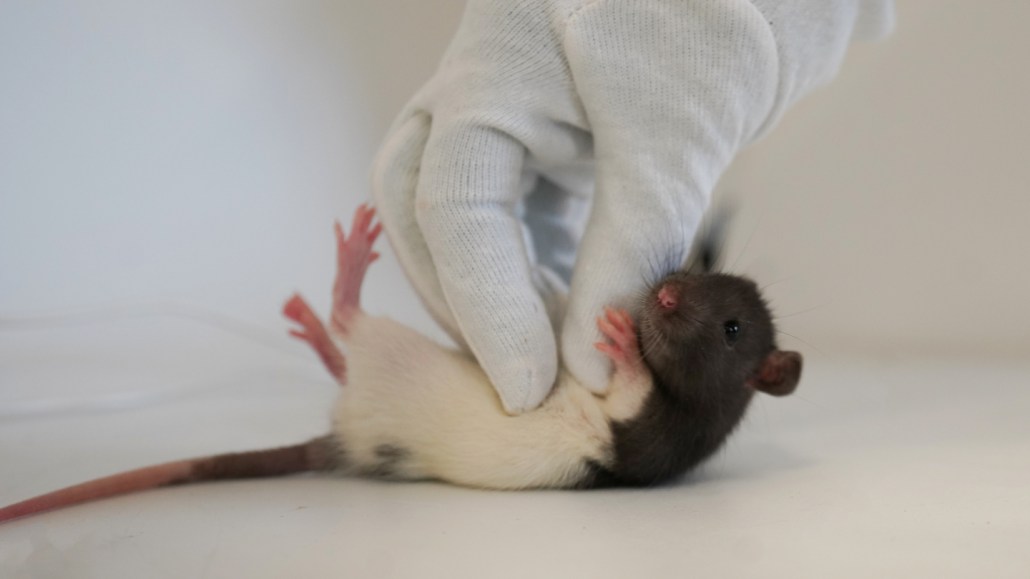A rat’s playfulness relies on cells in one part of its brain
Studying this pathway could improve our understanding of mood disorders in people

Rats are playful creatures by nature. Researchers have found a specific region in the rat brain where neurons turn on when the animals are tickled or play chase.
Natalie Gloveli
Share this:
- Share via email (Opens in new window) Email
- Click to share on Facebook (Opens in new window) Facebook
- Click to share on X (Opens in new window) X
- Click to share on Pinterest (Opens in new window) Pinterest
- Click to share on Reddit (Opens in new window) Reddit
- Share to Google Classroom (Opens in new window) Google Classroom
- Click to print (Opens in new window) Print
By Simon Makin
Listen to this story:
Have feedback on the audio version of this story? Let us know!
Despite their reputation, rats aren’t always busy roaming streets and rummaging through trash cans. It turns out that rats like to have fun. They enjoy playing chase. They even love a good tickle. Scientists have now identified a region in the brain that is central to this playfulness.
Neurons in one part of the brain are active in rats during different kinds of play, the researchers showed. It has a long name — the periaqueductal (Pair-ee-ak-wih-DUHK-tuhl) gray, or PAG, region. Blocking the action of those neurons makes the rodents far less playful.
Michael Brecht is a neuroscientist at Humboldt University in Berlin. He and his team reported their new findings July 28 in Neuron.
The brain’s role in play is poorly understood. “There are prejudices that it’s childish and not important,” Brecht says. In fact, he adds, “play is an underrated behavior.”
Jeffrey Burgdorf agrees. He’s a neuroscientist at Northwestern University in Evanston, Ill. His own work focuses on how to apply the neuroscience of play to finding therapies for mood disorders. Play might be a way we learn to bounce back from hardship, he says. Some scientists even relate it to being able to function at our best.
“When you’re playing,” he says, “you’re being your most creative, thoughtful, interactive self.”
Cue the giggles
For their study, Brecht and his team had to get rats used to being played with and tickled. They did this with a game of chase-the-hand.
When rats play, they squeal with glee. So the researchers recorded the rat giggles as a way to track when the rats were having fun. However, their squeals are at a frequency of 50,000 hertz. That’s well above what humans can hear.
The PAG team sits deep in the midbrain. Brecht’s group suspected this area played a role in many instinctual responses. It controls vocalizations, for instance, such as those playful squeals.
The researchers recorded activity in a rat’s individual PAG cells while it played chase-the-hand or was being tickled. Columns of cells extending down two sides of the PAG proved active during this play. “These cells really go crazy,” Brecht reports. Importantly, the same cells turn on during both chasing and tickling.
“This was where we thought: These are the cells,” Brecht says. “They’re not about moving, or touch. They’re about fun.”
Turning off playfulness
Placing rats on an elevated, brightly lit platform made them anxious. Now they were less apt to play and squeal. Activity in their “fun” PAG cells also fell, the team showed.
The researchers then altered the cells genetically so that they could be turned on with a beam of light. Blocking activity in these altered PAG cells caused the rats to play much less. They also appeared less ticklish, based on their failure to giggle.
These results suggest that PAG cells are required for play — likely as part of some circuit. Scientists had previously shown play-responsive neurons in a part of the brain that perceives the sense of touch. Yet animals without this part of the brain still play.
Brecht doesn’t think the same will be true for animals without the PAG cells they studied. “We think it’s a control structure for playfulness,” he says.
Understanding the brain’s play circuitry might provide some clues to depression. “The people that really, really need help are the ones that can’t play,” says Burgdorf at Northwestern. The new study is a step toward understanding what that looks like in the brain. And that, he suspects, could one day help doctors decide which treatments are best for patients who are depressed.
Next, the team in Berlin plans to look at other animals. They want to see how this PAG region might differ across species. Might it explain why some animals are more playful than others, Brecht wonders?
One of the first things he did after realizing PAG’s importance in rats was to look at this region in our brains. “And guess what? It’s very large,” he says. “That’s not a coincidence. No animal plays as many games as we do.”






